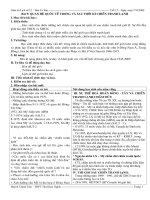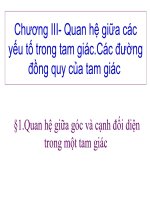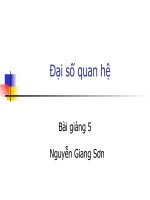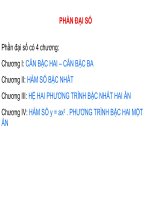Bài giảng đại số quan hệ
Bạn đang xem bản rút gọn của tài liệu. Xem và tải ngay bản đầy đủ của tài liệu tại đây (429 KB, 31 trang )
Đại số quan hệ
Bài giảng 5
Nguyễn Giang Sơn
10 Mar 2003 Nguyen Giang Son
2
Nội dung trình bày
Ngôn ngữ truy vấn quan hệ
Các phép toán trên đại số quan hệ
Ngôn ngữ truy vấn quan hệ
Query languages:
Allow manipulation and retrieval
of data from a database.
Relational model supports simple, powerful QLs:
Strong formal foundation based on logic.
Allows for much optimization.
Query Languages != programming languages!
QLs not expected to be “Turing complete”.
QLs not intended to be used for complex calculations.
QLs support easy, efficient access to large data sets.
Ngôn ngữ truy vấn quan hệ
hình thức
Two mathematical Query Languages form the
basis for “real” languages (e.g. SQL), and for
implementation:
❶
Relational Algebra
: More
operational
, very
useful for representing execution plans.
❷
Relational Calculus:
Lets users describe
what they want, rather than how to compute
it. (
Non-operational, declarative
.)
Mở đầu
A query is applied to
relation instances
, and the
result of a query is also a relation instance.
Schemas
of input relations for a query are fixed (but query
will run regardless of instance!)
The schema for the
result
of a given query is also fixed!
Determined by definition of query language constructs.
Positional vs. named-field notation:
Positional notation easier for formal definitions, named-field
notation more readable.
Both used in SQL
Thí dụ
“Sailors” and
“Reserves” relations
for our examples.
We’ll use positional or
named field notation,
assume that names of
fields in query results
are `inherited’ from
names of fields in
query input relations.
sid sname rating age
22 dustin 7 45.0
31 lubber 8 55.5
58 rusty 10 35.0
sid sname rating age
28 yuppy 9 35.0
31 lubber 8 55.5
44 guppy 5 35.0
58 rusty 10 35.0
sid bid day
22 101 10/10/96
58 103 11/12/96
R1
S1
S2
Đại số quan hệ
Basic operations:
Selection
( ) Selects a subset of rows from relation.
Projection
( ) Deletes unwanted columns from relation.
Cross-product
( ) Allows us to combine two relations.
Set-difference
( ) Tuples in reln. 1, but not in reln. 2.
Union
( ) Tuples in reln. 1 or in reln. 2.
Additional operations:
Intersection,
join
, division, renaming: Not essential, but
(very!) useful.
σ
π
−
×
Phép chiếu
π
sname rating
S
,
( )2
π
age
S( )2
Deletes attributes that are not
in
projection list
.
Schema
of result contains
exactly the fields in the
projection list, with the same
names that they had in the
(only) input relation.
Projection operator has to
eliminate
duplicates
!
Note: real systems typically
don’t do duplicate
elimination unless the user
explicitly asks for it.
Phép chiếu (tt.)
Another Example
π
sname rating
S
,
( )1
Phép chọn
)2(
8
S
rating >
σ
π σ
sname rating
rating
S
,
( ( ))
>8
2
Selects rows that satisfy
selection condition
.
No duplicates in result!
Schema
of result identical
to schema of (only) input
relation.
Result
relation can be the
input
for another
relational algebra
operation! (
Operator
composition.
)
Phép chọn (tt.)
Another example
σ
age
S
>
35
1( )
Phép Hợp, Giao, Hiệu
All of these operations take two
input relations, which must be
union-compatible
:
Same number of fields.
`Corresponding’ fields have
the same type.
What is the
schema
of result?
S S1 2∪
S S1 2∩
S S1 2−
Ví dụ
sid sname rating age
23 sandy 7 21.0
32 windy 8 19.5
59 rope 10 18.0
sid sname rating age
23 sandy 7 21.0
32 windy 8 19.5
45 jib 5 25.0
68 topsail 10 25.0
S3
S4
S S3 4
∪
S S3 4
∩
S S3 4
−
Phép Hợp, Giao, Hiệu (tt.)
S S3 4
−
!
"
S S3 4
∪
S S3 4
∩
Tích chập
Each row of S1 is paired with each row of R1.
Result schema
has one field per field of S1 and R1, with field
names `inherited’ if possible.
Conflict
: Both S1 and R1 have a field called
sid
.
ρ
( ( , ), )C sid sid S R1 1 5 2 1 1→ → ×
#$ #$
% % "
% % "
% % "
% % "
% % "
% % "
☛
Renaming operator&
Tích chập (tt.)
Work out cross product of S2 & R1 on board
Trả lời
#$ #$
%%"
%%"
%%"
%%"
%%"
%%"
%%"
%%"
Kết nối
Condition Join
:
Result schema
same as that of cross-product.
Fewer tuples than cross-product, might be able to
compute more efficiently
Sometimes called a
theta-join
.
R
c
S
c
R S = ×
σ
( )
#$ #$
% % "
% % "
11
.1.1
RS
sidRsidS <
Kết nối
Equi-Join
: A special case of condition join where the
condition
c
contains only
equalities
.
Result schema
similar to cross-product, but only one
copy of fields for which equality is specified.
Natural Join
: Equijoin on
all
common fields.
% % "
% % "
S R
sid
1 1
Phép chia
Not supported as a primitive operator, but useful for
expressing queries like:
Find
sailors who have reserved all boats
.
Let
A
have 2 fields,
x
and
y
;
B
have only field
y
:
A/B
contains all
x
tuples (sailors) such that for
every
y
tuple (boat) in
B
, there is an
xy
tuple in
A
.
Or
: If the set of
y
values (boats) associated with an
x
value
(sailor) in
A
contains all
y
values in
B
, the
x
value is in
A/B
.
In general,
x
and
y
can be any lists of fields;
y
is the
list of fields in
B
, and
x U
y
is the list of fields of
A
.
Ví dụ A/B
A
B1
B2
B3
A/B1
A/B2
A/B3
Biểu diễn A/B
bằng các phép cơ bản
Division is not essential op; just a useful
shorthand.
(Also true of joins, but joins are so common that
systems implement joins specially.)
Idea
: For
A/B
, compute all
x
values that are
not `disqualified’ by some
y
value in
B
.
x
value is
disqualified
if by attaching
y
value from
B
, we obtain an
xy
tuple that is not in
A
.
'()x*&
A/B:
π π
x x
A B A(( ( ) ) )× −
π
x
A( ) −
()
Biểu diễn A/B
bằng các phép cơ bản – ví dụ
Tính
A/B2
π
sno
A
π
sno
A
+,
π
sno
A
+,
$-.
#
π
sno
A
+,
$-.
#
π
sno
#
$
π
sno
A
+,
$-.
#
π
sno
#
$$/
π
sno
A
-#
Biểu diễn A/B
bằng các phép cơ bản – ví dụ
Tính A/B2
Biểu diễn A/B
bằng các phép cơ bản – ví dụ
π
sno
A
π
sno
A
+,
π
sno
A
+,
$-.
#
π
sno
A
+,
$-.
#
π
sno
#
$
π
sno
A
+,
$-.
#
π
sno
#
$$/
π
sno
A
-#
Ví dụ
sid sname rating age
22 dustin 7 45.0
31 lubber 8 55.5
58 rusty 10 35.0
sid sname rating age
28 yuppy 9 35.0
31 lubber 8 55.5
44 guppy 5 35.0
58 rusty 10 35.0
sid bid day
22 101 10/10/96
58 103 11/12/96
R1
S1
S2
B1
bid bname bcolor
101 Gippy
red
103 Fullsail
green
Boats
Reserves
Sailors









